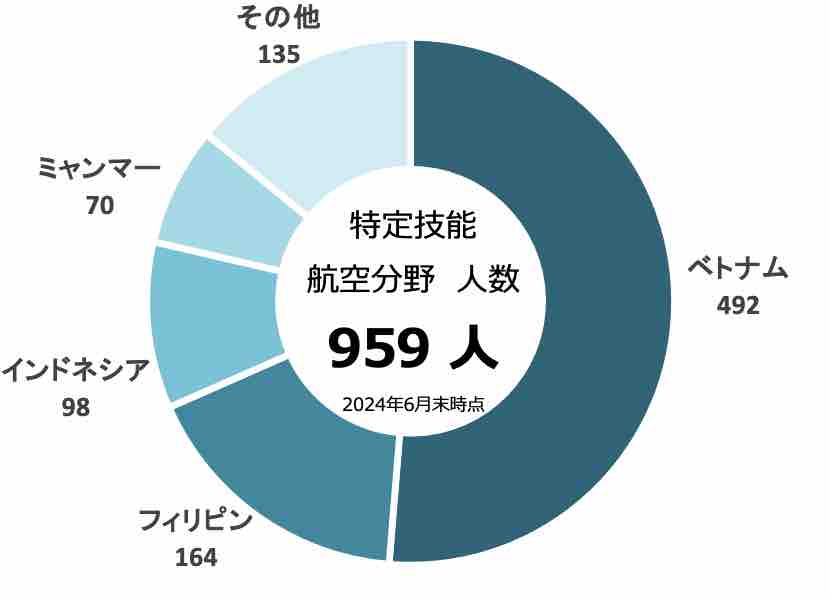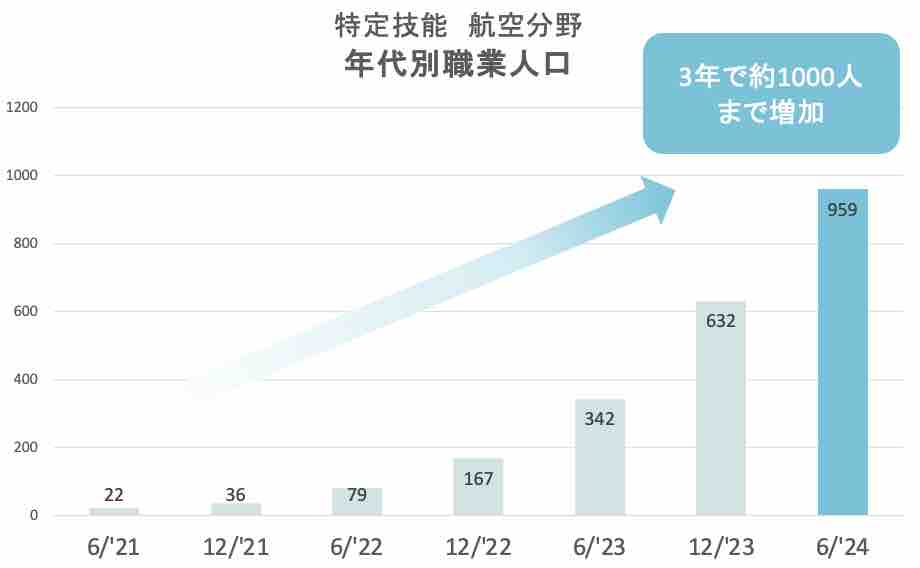Job Introduction - Aviation
This page provides information to help with career choices, such as types of jobs in aviation, their annual income, current worker numbers, and job descriptions.
Index
- 1. What is SSW in the Aviation Industry?
- 2. Job details
- 3. Required Exams and Qualifications
1. What is SSW in the Accommodation Industry?
1-1 Background
The aviation industry is facing a severe labor shortage due to factors such as the declining birthrate and the diversification of career choices. As the average age of aviation workers rises, it has become difficult to secure enough domestic talent. In response to this situation, a system was introduced to accept foreign workers.
1-2 Population and Current Status
The Immigration Services Agency aggregates and publishes the number of people working under the SSW qualification every six months (previously every three months until 2022). According to the data, the population ratio by country or age is as follows.

As of the end of June 2024, there are 959 people working in the SSW aviation industry. Most of the workers are from Asia, with Vietnam, the Philippines, Indonesia, and Myanmar being the top countries of origin.

Although the SSW system began in 2019, the population of workers in the aviation industry has increased by 1,000 over the past three years, and the number is expected to continue expanding.
source : 出入国在留管理庁(https://www.moj.go.jp/isa/applications/ssw/zairyuarchive.html)
There are two systems for accepting foreign workers: the Technical Intern Training Program and the SSW Program, but their purposes and characteristics are quite different.
The Technical Intern Training Program aims to equip young people from developing countries with Japanese technical skills, enabling them to contribute to their home countries' development after returning. The main purpose is skill acquisition, and it is positioned as training rather than labor. Therefore, job changes are not allowed, and the maximum duration is five years.
On the other hand, the SSW Program was established to supplement Japan's labor shortage. There are two types, SSW 1 and SSW 2, which accept foreign workers as immediate assets. Job changes are allowed, and in SSW 2, it is possible to bring family members and even apply for permanent residency. A test to prove skills and Japanese language ability is required, and workers with practical experience are preferred.
In addition, foreign workers who have completed the Technical Intern Training Program can transition to the SSW Program. Experience gained through technical training is recognized, and part of the SSW 1 test is exempted, making the transition relatively smooth. This allows foreign workers to continue working in Japan for a longer period after completing their internships, with opportunities for job changes and career advancement.
2. About Jobs and Duties in the Accommodation Industry
2-1 2-1 Job Description
The main duties under the "Aviation Industry" SSW are in Ground Handling and Aircraft Maintenance.
The main tasks in Ground Handling are as follows:
- Aircraft Ground Movement Support
- Baggage and Cargo Handling
- Loading and Unloading of Baggage and Cargo
- Cleaning and Maintenance of the Aircraft Interior and Exterior
This involves guiding and ensuring the safety of aircraft during movements on the ground, such as taxiing on runways or to parking spots. The role uses vehicles and signals to safely guide the aircraft to its parking position.
This task manages and transports passengers' luggage and cargo from the check-in counter to the aircraft or to the arrival area at the destination. It includes sorting and transporting luggage and cargo.
This task involves loading luggage and cargo into the aircraft's cargo hold and unloading them after the aircraft reaches its destination. The task ensures proper arrangement and safe handling of the cargo.
This includes cleaning the inside and outside of the aircraft, cleaning seats and restrooms, and preparing the cabin to maintain comfort for passengers.
Aircraft Maintenance involves performing basic maintenance tasks under the guidance and supervision of experts. Specific tasks include the following:
- Operational Maintenance
- Airframe Maintenance
- Component and Engine Maintenance
This is basic maintenance conducted in a short period between the aircraft's arrival and the next flight.
Typically conducted every 1 to 1.5 years, this involves detailed inspection and maintenance of the entire aircraft, which takes about 1-2 weeks.
This specialized task involves maintaining parts removed from the aircraft, such as landing gear, control surfaces, instruments, and engines.
2-2 Average Salary
The average monthly salary for workers in the "Aviation Industry" SSW has not been disclosed, but companies are required to provide social insurance and welfare benefits, such as health care and pensions, ensuring secure support. Furthermore, aviation is a technical profession, offering opportunities for pay raises as you gain experience. Working in the aviation industry under SSW offers both skill development and stable income, making it an attractive career choice.
3. Required Exams and Qualifications
To obtain the "Aviation Industry" SSW qualification, you must pass both a Japanese language test and a skill test.
3-1 Japanese Language Test
There are two types of Japanese language tests: the Japanese Language Proficiency Test (JLPT) and the Japan Foundation Test for Basic Japanese (JFT-Basic), and you must pass one of them.
The Japanese Language Proficiency Test (JLPT) evaluates the Japanese language ability of non-native speakers. JLPT has five levels (N1, N2, N3, N4, N5), with N1 being the most difficult and N5 being the easiest. To meet the requirements of the SSW test, you must pass N4 or higher. N4 is the level that demonstrates the ability to understand basic Japanese, and it tests whether you can engage in everyday conversations and read simple texts.
- Time: Twice a year (July and December)
- Test Locations: Various countries and regions around the world
- How to Apply: Online or by mail
- Test Method: Mark sheet (on-site)
source : 日本語能力試験 JLPT(https://www.jlpt.jp/index.html)
The Japan Foundation Test for Basic Japanese (JFT-Basic) has six levels (A1, A2, B1, B2, C1, C2), with C2 being the most difficult and A1 being the easiest. To meet the requirements of the SSW test, you must pass A2 or higher. A2 is the level that demonstrates the ability to understand basic Japanese, and it tests whether you can engage in everyday conversations and read simple texts.
- Time: Anytime throughout the year
- Test Locations: Various countries and regions around the world
- How to Apply: Online reservation
- Test Method: CBT (Computer-Based Testing)
source : 国際交流基金日本語基礎テスト JFT-Basic(https://www.jpf.go.jp/jft-basic/)
This site summarizes detailed test structures, sample questions, test information, and strategies for the Japanese Language Proficiency Test (JLPT) and the Japan Foundation Test for Basic Japanese (JFT-Basic).
3-2 3-2 Skill Evaluation Test
The aviation SSW exam evaluates the basic knowledge and skills required to work as an aviation technician in Japan. The exam is of intermediate difficulty (equivalent to Grade 3 Skills Test). It is conducted by the Japan Aviation Promotion Association (JASPA) under the guidance of the Ministry of Land, Infrastructure, Transport, and Tourism. There are both written and practical tests, and those who pass can obtain the SSW qualification and work legally in Japan.
- Time: Anytime throughout the year
- Test Locations: Various countries and regions around the world
- How to Apply: Online reservation
- Test Method: CBT (Computer-Based Testing)
This site summarizes detailed test structures, sample questions, test information, and strategies for the aviation SSW exam.